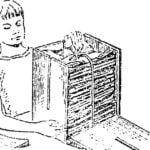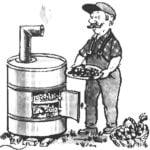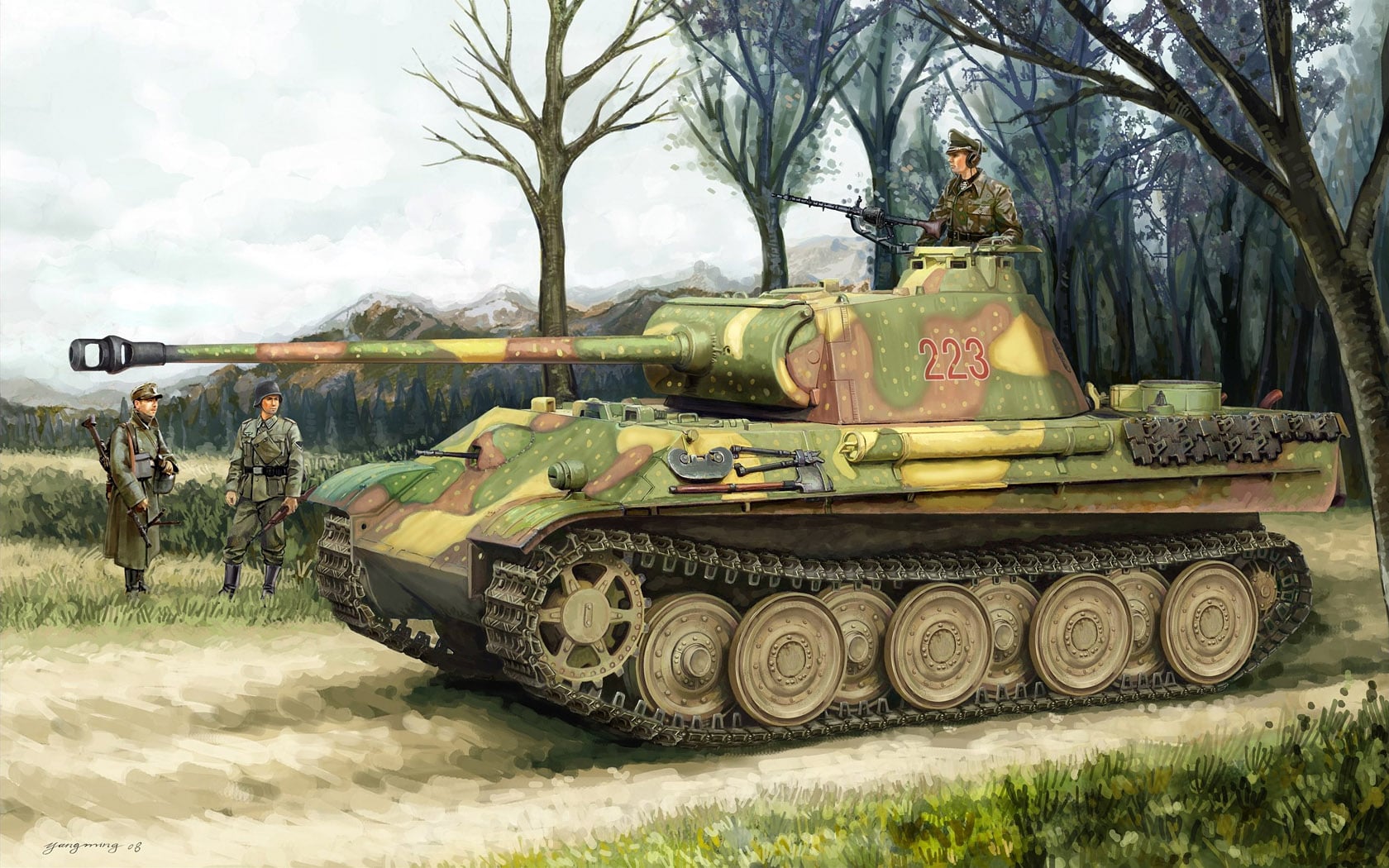 Of course, the “Panther” is one of the most famous heavy tanks, took part in the Second world war. The catalyst for the creation of this not provided in the system tank weapons of the Wehrmacht military machine was a Soviet medium tank T-34. His appearance on the Eastern front forced the Ministry of arms of Germany to suspend the work, which in 1937 led the company Henschl tank on a promising 30-ton class. Firm Rheinmetal July 18, 1941 received an order to develop a long-barreled 75-mm gun, able to penetrate 140 mm armor at a distance of 1000 m. the Daimler-Benz and MAN on November 25 were, in turn, issued orders for the 35-ton tank. Tactical and technical requirements for the new military machine has put forward the following: width up to 3150 mm, height 2990 mm, the engine capacity of 650-700 HP, armor protection, 40 mm, maximum speed 55 km/h. the Task was given the code name “Panther”.
Of course, the “Panther” is one of the most famous heavy tanks, took part in the Second world war. The catalyst for the creation of this not provided in the system tank weapons of the Wehrmacht military machine was a Soviet medium tank T-34. His appearance on the Eastern front forced the Ministry of arms of Germany to suspend the work, which in 1937 led the company Henschl tank on a promising 30-ton class. Firm Rheinmetal July 18, 1941 received an order to develop a long-barreled 75-mm gun, able to penetrate 140 mm armor at a distance of 1000 m. the Daimler-Benz and MAN on November 25 were, in turn, issued orders for the 35-ton tank. Tactical and technical requirements for the new military machine has put forward the following: width up to 3150 mm, height 2990 mm, the engine capacity of 650-700 HP, armor protection, 40 mm, maximum speed 55 km/h. the Task was given the code name “Panther”.
Tank, designed by Daimler-Benz, externally strongly resembled the T-34, but, nevertheless, like Hitler. With the Soviet machine was completely copied the layout features a rear motorostroitelnoe compartment and wheels. Eight rollers of large diameter are blocked by two and had leaf springs as the elastic element of the suspension. Soon, however, developed a variant of the undercarriage with the staggered arrangement of rollers and torsion bar suspension. Supposed to be used on the tank diesel engine Daimler-Benz MB 507. In early February 1942 began construction of a prototype — VK 3002(DB), and four weeks later, Hitler ordered armaments Minister Speer to issue a firm order for the first 200 cars. However, the point of view of the Fuhrer did not find understanding and support at the Ministry of armaments, experts believed that in wartime conditions, similar in appearance to the T-34 could cause a fire the tank of his own artillery. The project is the company MAN who had a traditional German layout with a front drivetrain and wheels, seemed to them preferable, although it was much more complicated. In fairness it should be noted that during the Second world war all the warring parties repeatedly fired on their own tanks, regardless of their similarity with the enemy tanks. So the argument against the car company Daimler-Benz can be considered to be largely false.
However, on may 13, 1942 Hitler was told conclusion of experts on both projects: the preference clearly given to the tank company MAN.
Designers Pz.Kpfw.V (name “Panther” without mentioning the army entered the index on the orders of the Fuhrer only from 27 February 1944) was chief engineer of tank Department of the company MAN P. Vibecke and engineer G. Kniepkamp of management improvement and testing of weapons.
First serial “Panther” left the factory floor of the company MAN January 11, 1943. Tanks “zero” series (20 units) were designated Ausf.And, while they had nothing to do with the cars produced later in September 1943.
A characteristic feature of the first serial “Panther” was the commander’s cupola with the tab-tide on the left side of the tower and a single chamber “pear-shaped” muzzle brake of the gun. Tanks were equipped with engines Maybach HL 210Р45 and had frontal armor thickness of 60 mm., They were used only in the rear for crew training. Since February 1943 the designation of machines of this series was changed to Ausf.D1. Still we can not say exactly why the first large-scale modification “Panther” was designated D. Perhaps the letters b and C reserved for other options.
Tanks Pz.Kpfw.V Ausf.D (this and subsequent modifications of the index via notation of combat vehicles of the Wehrmacht was the same — Sd.Kfz.171) slightly differed from the prototypes and machines “zero” series. The changes affected mainly commander’s cupola and gun muzzle brake — they have acquired a more familiar “panterovsky”. The thickness of the frontal armor increased to 80 mm. tanks mounted 230Р30 HL engine and gearbox AK-7-200.
It should be noted that the machines release the first half of 1943 commander’s cupola was similar to the turret “Tiger”, later it was replaced by a new, seven-periscope observation devices on the perimeter and a special ring to install anti-aircraft machine gun MG 34.
On the sides of the tower were fastened mortice NbK 39 to start the smoke grenade caliber of 90 mm.
Armor tanks, released in the second half, covered “timeritem”, in addition, they were equipped with bulwarks made of 5-mm armor plates.
The characteristic features of the machine series D (officially D2) are the lack of a ball machine gun installation course (it was located inside the tank, for the shooting was inserted into a narrow vertical slit, zakryvayutsya hinged lid), as well as the presence in the left side of the turret hatch round to eject spent cartridges and loopholes for firing personal weapons in the sides and rear of the turret.
To make up for losses incurred in the battles at Kursk, was installed beginning in August 1943, the monthly production plan — 250 “Panther”! However, in August produced only 120 tanks — as a result of the bombing allied aircraft were badly damaged plants of the company MAN in Nuremberg and Daimler-Benz in Berlin. Failed to execute the plan and in September (197 cars), and only in October the factory shops left 257 tanks!


Heavy tank “Panther” Ausf.G (late production):
1 — 75-mm gun; 2 — mounting bracket of the gun in its stowed position; 3 —mask gun late type (with “skirt”); 4 — fan cover; 5 — the container, swab; 6 — antenna; 7 — bulwarks; 8 — spare tracks; 9 — set exchange machine gun; 10 — Luke gunner-radio operator; 11 — fencing of the surveillance device radioman: 12 — enclosure of the surveillance device charging; 13 — cover of the hatch of the commander; 14 — recess device of the melee; 15—air receiver window of the cooling system of the engine; 16 — hatch of the engine compartment; 17 — window vent valves of the cooling system of the engine; 18 — air vents to supply air to the air filter; 19 — a hatch for access to the neck of fuel tanks; 20 — lucht fill water in cooling system; 21 — driver’s hatch; 22 — a surveillance device of the driver; 23 — hatch for Assembly and disassembly of the transmission and rotation mechanism: 24 — fan cover compartment; 25— recess coaxial machine gun; 26 — rail mounting anti-aircraft machine gun; 27— recess of the telescopic sight; 28— lights with svetamaksimova nozzle; 29— box for gear: 30 — manhole for loading and unloading of crew: 31 — Jack: 32 — plamegasiteli on the exhaust pipe: 33 — hatch for access to the drive inertia starter: 34 — hatch to access the engine drive from crank: 35 — a hatch for access to the engine compartment: 36 — Luc to access the hot-water boiler cooling system: 37 — hatch to access the mechanism of a tension of caterpillars
From September 1943 began production of the next modification of the “Panther” — Ausf.. The changes made little: is quite useless in combat, and a drag ball appeared to install exchange machine gun in the hull, designed by Daimler-Benz even for its prototype VK 3002(DB); eliminated hatch to eject spent cartridges and loopholes for firing personal weapons in the sides of the tower; instead of two lights on the upper front hull has only installed one. Binocular gun sight was replaced by the monocular TZF 12A. The angle of elevation of the tank guns reduced from 20° (as in Ausf.D) to 18°.
Modification Ausf.G — the most massive of the three (produced 3740 tanks) — launched into production in March 1944. The side plates hull got the inclination angle 61° (variants D and A — 50°), the thickness of the side armor increased to 50 mm, and the frontal armor of the turret — up to 110 mm of front hull was deleted hatch-stopper of the driver. Boarding hatches gunner and the driver began to lean on the hinges to the sides and not to move as the previous versions. Part of the tanks received a mask with a specific gun “skirt” at the bottom, making it impossible for jamming towers when hit with a projectile. At three shots increased gun ammunition. Changes were made in the design of fans, blinds engine, exhaust pipes, etc.
Tanks G series planned to equip the road wheels without rubber tires, but the complete lack of photos of military vehicles with such a chassis gives grounds to assume that the project remained on paper. Neobressorennymi machine with rollers in the experimental procedure has built a firm MAN in September 1944. Some serial “Panther” had a single neobrazovannie rinks on the last axis.
The use of allies in increasing volumes of aircraft to fight German tanks (especially after opening a second front in Europe) has reduced the possibility of movement of tank units a day to almost zero. There was a question about the equipment of tanks with night vision devices, on which work was carried out by the firm AEG in 1936. As a result, the commander’s cupola “Panther” was mounted an infrared spotlight illuminator power of 200 W and a surveillance device, which allowed to explore the area from a distance of 200 m. the driver of this device had and drove, following the instructions of the commander. To fire the night, needed a more powerful illuminator.
For this purpose, at half-track armored personnel carrier Sd.Kfz.250/20 was installed infrared illuminator Uhu 6 kW, which provides work night vision device at a distance of 700 m. Tests passed successfully, and the company Leitz-Wetzlar produced 800 sets of optics for night vision systems. In November 1944 Panzerwaffe received 63 “Panther”, equipped with the world’s first serial active night vision devices. Firm Zeiss-Jena developed even more powerful device, allowing to “see” at a distance of 4 km, however, due to the large size of the illuminator — diameter 600 mm — application of the tank “Panther”, he has not found.
In 1943 he started designing the next modification of the “Panther” — Ausf.F, which was significantly different from previous models. The most important innovation was the tower, dubbed Schmalturm (“narrow” or “cramped tower”), which was less than standard and had a different design.
During 1944, manufactured, and tested several prototypes. The design was finished only in January 1945.
In the end, the armor thickness of the turret was: forehead 100 mm Board and feed 50 mm, the roof is 30 mm. In front of the compartment, there was still a loophole for telescopic sight TZF 13. In the final version of the frontal armor increased to 120, side — 60, and armor of the roof — up to 40 mm Established a new stabilized periscope sight TZF 1 and stereoscopic rangefinder company Zeiss. Rangefinder with a base of 1320 mm and 15-fold increase was located in front of the tower, the sides of which were armored caps for the eyepieces. Provided and installation of night vision device FG 1250.
Mask gun type Saukopfblende (“pig’s snout”) thickness of 120 mm was applied on the tank like “Tiger II”.
Innovation was not spared and armament of the tank. And if the gun remains the same and was just upgraded factories Skoda — she lost her muzzle brake and received index KwK 44/1, tower machine gun MG 34 was replaced by MG 42. Is exchange machine gun mounted machine MP 44. Mounting arms in the tower was carried out at factories Krupp and Skoda.
The changes affected not only the tower, but the case. The thickness of the roof increased from 17 to 25 mm, changed the hatches for driver and radio operator-gunner.
Tested and two new engine: Deutz T8M118 700 HP (515 kW) and Maybach HL 234 with direct fuel injection and a power of 850 HP (625 kW).
Until the end of the war does not add any prototype in its final form, although mass production was planned to begin in June 1945. In the beginning, the company Daimler-Benz chassis assembled with a standard tower from Ausf.G. In turn, “close the tower” installed on the chassis Ausf.G and experienced in Kummersdorf. However, instead of the standard guns in the turret mounted standard “panterovsky” KwK 42 gun with a muzzle brake. Total for “Panther” Ausf.F produced eight buildings and two towers, but no tanks of this modification was not collected.
In February 1943, were developed tactical and technical requirements for the tank “Panther II”, suggesting a high degree of unification of tanks “Tiger II” and “Panther”. To realize it was simply because the plants Henschel produced cars of both types.
On the “Panther II” was supposed to use “close the tower” and the new building. His frontal armor reached 100, side 60, and aft 40 mm. Armament — 88 mm cannon KwK 43/2 with a barrel length of 71 gauge (elevation angle + 15°). Since in this case the mass of the tank exceeds 50 m, the question arose about the new power plant. As variants were considered engines Maybach HL 234, Simmering Sla 16 (720 HP) and MAN/Argus LD 220 (700 HP). In 1945, for the “Panther II” started designing a new tower with 150-mm frontal armor.
Neither of the two prototypes (the order of their production, the Office of arms issued in late 1944) was not completed. To more or less high degree of readiness brought the same chassis, setting him on a tower from the Ausf.G. It is interesting to note that in parallel with the design of the “Panther II” was being developed tank E-50, designed to replace it.
During the work on Ausf.F and “Panther II” firm Krupp twice offered the usual options of re Panther gun KwK 43 L/71 caliber 88 mm, but to no avail. Remained on paper and draft equipment Panther 100-caliber 75-mm cannon with a muzzle velocity of 1250 m/s.
M. KNYAZEV
Recommend to read
 DO YOU HAVE WASTE PAPER?
DO YOU HAVE WASTE PAPER?
The time has passed when the collection of waste paper was only the students. Today many adults are willing to collect waste paper to exchange them for interesting book subscription.... SIMPLE DRYER
SIMPLE DRYER
For its equipment fit any barrel Inside arrange mesh shelves outside the exhaust pipe with a valve on the bottom set the oil heater. Herbs plant or fruit first, provyalivayut in air and...
 Of course, the “Panther” is one of the most famous heavy tanks, took part in the Second world war. The catalyst for the creation of this not provided in the system tank weapons of the Wehrmacht military machine was a Soviet medium tank T-34. His appearance on the Eastern front forced the Ministry of arms of Germany to suspend the work, which in 1937 led the company Henschl tank on a promising 30-ton class. Firm Rheinmetal July 18, 1941 received an order to develop a long-barreled 75-mm gun, able to penetrate 140 mm armor at a distance of 1000 m. the Daimler-Benz and MAN on November 25 were, in turn, issued orders for the 35-ton tank. Tactical and technical requirements for the new military machine has put forward the following: width up to 3150 mm, height 2990 mm, the engine capacity of 650-700 HP, armor protection, 40 mm, maximum speed 55 km/h. the Task was given the code name “Panther”.
Of course, the “Panther” is one of the most famous heavy tanks, took part in the Second world war. The catalyst for the creation of this not provided in the system tank weapons of the Wehrmacht military machine was a Soviet medium tank T-34. His appearance on the Eastern front forced the Ministry of arms of Germany to suspend the work, which in 1937 led the company Henschl tank on a promising 30-ton class. Firm Rheinmetal July 18, 1941 received an order to develop a long-barreled 75-mm gun, able to penetrate 140 mm armor at a distance of 1000 m. the Daimler-Benz and MAN on November 25 were, in turn, issued orders for the 35-ton tank. Tactical and technical requirements for the new military machine has put forward the following: width up to 3150 mm, height 2990 mm, the engine capacity of 650-700 HP, armor protection, 40 mm, maximum speed 55 km/h. the Task was given the code name “Panther”.





